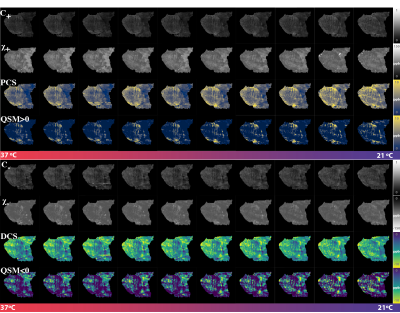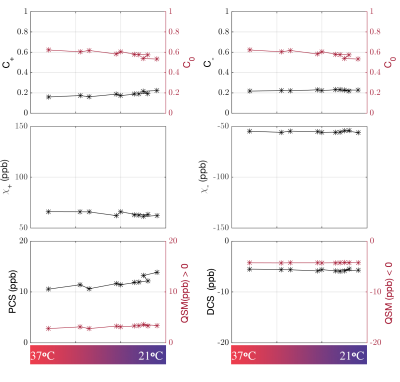Jingjia Chen1, Khallil Taverna Chaim2, Maria Concepción García Otaduy2, and Chunlei Liu1,3
1Department of Electrical Engineering and Computer Sciences, University of California, Berkeley, Berkeley, CA, United States, 2LIM44, Instituto e Departamento de Radiologia, Faculdade de Medicina, Universidade de Sao Paulo, Sao Paulo, Brazil, 3Helen Wills Neuroscience Institute, University of California, Berkeley, Berkeley, CA, United States
1Department of Electrical Engineering and Computer Sciences, University of California, Berkeley, Berkeley, CA, United States, 2LIM44, Instituto e Departamento de Radiologia, Faculdade de Medicina, Universidade de Sao Paulo, Sao Paulo, Brazil, 3Helen Wills Neuroscience Institute, University of California, Berkeley, Berkeley, CA, United States
DECOMPOSE QSM is being validated through ex vivo QSM acquisitions under various temperatures. Indirect temperature measurements are performed by analyzing chemical shift of water proton spectrum.

Figure 3. Parameter maps, paramagnetic component susceptibility (PCS) and diamagnetic component susceptibility (DCS) compared to thresholding QSM. The line artifact in the third column is due to a dicom file error of two slices in the magnitude images. The increasing trend of PCS is visible, while the temperature related change in DCS is minimal.

Figure 2. DECOMPOSE QSM results for 16 echoes data set. Mean value of each parameters of all 10 scans are shown. Temperatures range from 37 °C to 21 °C. Mean value is calculated from the non-zero mean of one representative slice. Note the paramagnetic component susceptibility is increasing with decreasing temperature as expected.
